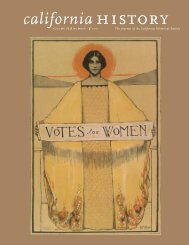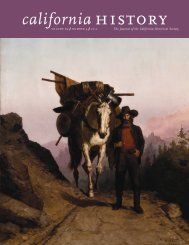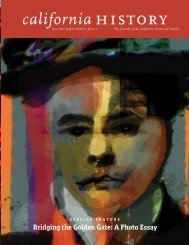Volume 90, Number 1 - California Historical Society
Volume 90, Number 1 - California Historical Society
Volume 90, Number 1 - California Historical Society
You also want an ePaper? Increase the reach of your titles
YUMPU automatically turns print PDFs into web optimized ePapers that Google loves.
after the re-conquest of Spain, Franciscan priests<br />
from the Monastery of Saint Francis assembled<br />
with weapons at the ready to fight Muslims who<br />
rebelled against the Crown. (It is not clear if the<br />
priests went to battle.) During the same episode,<br />
four Franciscans and an equal number of Jesuits,<br />
doubting the bravery of Spanish soldiers, offered<br />
their services to one of the military commanders,<br />
declaring that they “wished to die for Jesus<br />
Christ.” 62 He denied their request.<br />
In the Americas, some clergy found more opportunities<br />
to take up the sword. The buildings missionaries<br />
constructed, or at least asked others to<br />
construct on their behalf, embodied the principle<br />
that force and faith were compatible. As the<br />
art historian George Kubler explains, when the<br />
Franciscans and other missionary orders proselytized<br />
Mexico’s Indians, they employed “the<br />
extremely unusual habit of fortifying the church.”<br />
The priests built churches surrounded by “a vast<br />
courtyard” with “crenellated walls.” The Arabist<br />
T. B. Irving adds that many Mexican churches<br />
during the colonial era resembled the “open-air<br />
congregational type of mosque which was built<br />
by Muslims for army worship.” 63<br />
Apart from churches, some seminaries in Mexico<br />
that trained priests to establish missions recalled<br />
the shape and function of the ribat as fortress.<br />
Admittedly, any resemblance may be accidental.<br />
But however inadvertent, the seminary’s purpose,<br />
and the descriptions it prompted from observers,<br />
brings to mind the Muslim effort to prepare the<br />
mind and body for any challenge. Father Francisco<br />
Palóu, Junípero Serra’s biographer, hinted<br />
at the parallels when he repeated a colleague’s<br />
description of how priests and novices in the<br />
eighteenth century prepared for their calling.<br />
“What praise and appreciation,” he recounted,<br />
“may reach the merit of these men who, ordinarily<br />
observing within the cloister walls of their<br />
college [seminary] an austere religious life, busy<br />
continually with their divine services, find their<br />
recreation in going out . . . to sanctify with their<br />
missions all of North America.” 64<br />
The buildings missionaries<br />
constructed, or at least<br />
asked others to construct<br />
on their behalf, embodied<br />
the principle that force and<br />
faith were compatible.<br />
Through the years, other clergy consecrated<br />
war in their own manner. Francisco López de<br />
Gómara, a secular priest who became Cortés’s<br />
chaplain and biographer, noted that war helped<br />
spread the Gospel. He claimed that Cortés<br />
told his men on the march to the Aztec capital<br />
Tenochtitlán that “it is foreign to our Spanish<br />
nation” to refuse the challenge of war and forsake<br />
the chance “to exalt and increase Our Catholic<br />
Faith.” 65 Juan Ginés Sepúlveda, a Dominican<br />
priest, argued that the “Spaniards were especially<br />
noted for warfare and government, and hence<br />
best [suited] for the mission of bringing the gospel<br />
and civility to the conquered peoples of the<br />
Americas.” 66<br />
In the late eighteenth century, Father Romualdo<br />
Cartagena, rector of the College of Santa Cruz in<br />
Querétaro, claimed that “soldiers” with “glistening”<br />
swords were more effective than “the voice<br />
of five missionaries.” 67 A century later, a commentator<br />
praised Father Isidoro Felix de Espinosa<br />
for writing about the conversion of Mexico’s<br />
Indians with a soldier’s resolve: “He was the<br />
Julius Caesar of New Spain [Mexico], for like that<br />
ancient Roman, he fought by day . . . and wrote<br />
by night.” 68<br />
35









